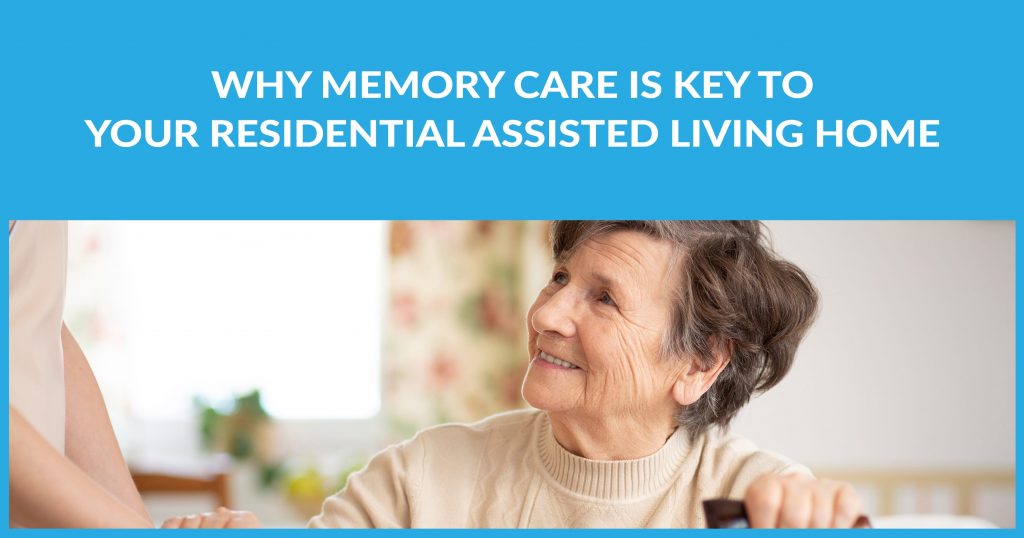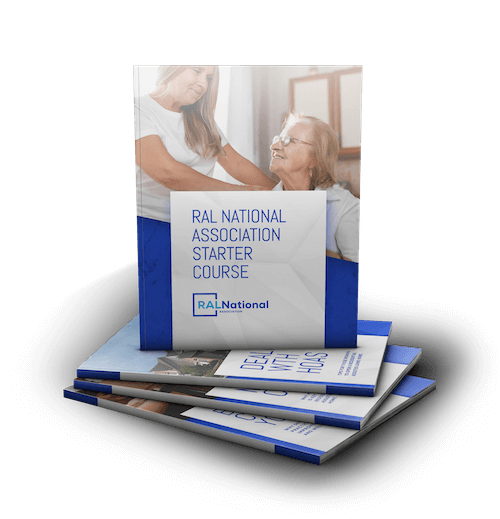[vc_row css_animation=”” row_type=”row” use_row_as_full_screen_section=”no” type=”full_width” angled_section=”no” text_align=”left” background_image_as_pattern=”without_pattern”][vc_column][vc_empty_space][vc_column_text]
UNDERSTANDING MEMORY CARE
[/vc_column_text][vc_empty_space height=”16px”][vc_column_text]There is a distinct difference between operating a traditional assisted living home vs. providing memory care services. Most people have no point of reference as to how the brain of memory care patients work. It is important to consider all the critical components when implementing memory care into your residential assisted living home. One of the most serious concerns for seniors suffering from memory care is avoiding falls. Brain atrophy is when the brain shrinks. During falls, seniors with this condition experience the tormenting sensation of their brain rattling in their skull. Seniors who suffer from falls are at an even greater risk of extended brain damage from severe brain shaking.[/vc_column_text][vc_empty_space height=”16px”][vc_column_text]This is one of the many reasons why seniors suffering from memory loss need assisted living conditions that accommodate their specific needs. The following content outlines 7 significant step-by-step processes RAL home owners should consider prior to providing memory care services: [/vc_column_text][vc_empty_space height=”16px”][vc_empty_space height=”16px”][vc_column_text]
- Can The Brain Actually Shrink?
- Tackling Risks Associated with a Shrinking Brain?
- Why Create a Memory Care Component To Your RAL Home?
- Traditional Assisted Living Vs. Memory Care Assisted Living
- Three Distinct Differences Between Memory Care And Assisted Living
- Other Differences Between Memory Care And Assisted Living
- Advantages Of Adding A Memory Care Component To Your RAL Home
[/vc_column_text][vc_empty_space height=”16px”][vc_column_text]There are 5 million Americans dealing with dementia. Although there are various forms of dementia, around 70 percent of cases are due to Alzheimer’s. This number is expected to rapidly increase over the next 30 years with the influx of the baby boomer generation. This is why residential assisted living home owners and operators will need to understand the complicated concept of providing memory care. This concept starts with understanding the different dynamics of memory loss.[/vc_column_text][vc_empty_space height=”16px”][vc_column_text]
I. WHY DOES THE BRAIN SHRINK?
[/vc_column_text][vc_empty_space height=”16px”][vc_column_text]The term atrophy means loss of cells or shrinkage. When the brain shrinks, the neurons, and their connections waste away and the brain literally gets smaller. This condition may cause dementia, including memory loss, executive functioning impairment and behavior changes. It can cause difficulties expressing language and comprehension skills. Dementia can also cause muscle weakness and hearing loss.[/vc_column_text][vc_empty_space height=”16px”][vc_column_text]
Causes of Cerebral Atrophy in Seniors
[/vc_column_text][vc_empty_space height=”16px”][vc_column_text]Several different medical conditions can cause brain shrinkage amongst the elderly:[/vc_column_text][vc_empty_space height=”16px”][vc_column_text]
- Alzheimer’s Disease: It is a specific disease that slowly and irreversibly destroys memory and thinking skills. Eventually, Alzheimer’s disease takes away the ability to carry out even the simplest tasks.
- Frontotemporal Dementia: (FTD) is the most common form of dementia for people under age 60. It represents a group of braindisorders caused by degeneration of the frontal and/or temporal lobes of the brain.
- Lewy Body Dementia: (LBD) is the second most common type of dementia, with an estimated 1.3 million Americans diagnosed. It refers to a type of dementia associated with abnormal protein deposits in the brain called Lewy bodies, which affect how the brain functions.
- Stroke: A stroke happens when there is an interruption of blood flow to a region of the brain causing brain damage.
- Huntington’s Disease: A progressive neurodegenerative disease that is passed on genetically from parents to children. In HD, the person’s brain cells begin to degenerate, causing physical, cognitive and emotional problems. Classic symptoms include dementia.
- Age-Related Atrophy: As people age, a small amount of brain shrinkage is expected.
[/vc_column_text][vc_empty_space height=”16px”][vc_column_text]
Elderly people living with memory loss can continue maintaining healthy lifestyles by obtaining quality care in a safe environment. Trained residential assisted living staff can help seniors take steps to slow the process. All shrinkage is not dementia related. Seniors can tackle the disease by getting connected to RAL homes that have a better understanding of the root causes.
[/vc_column_text][vc_empty_space height=”16px”][vc_column_text]
II. TACKLING RISKS ASSOCIATED WITH A SHRINKING BRAIN
[/vc_column_text][vc_empty_space height=”16px”][vc_column_text]Age-related brain atrophy does not necessarily mean that dementia is developing. In some cases, physical exercise can reduce the speed of atrophy or even reverse some of the atrophy in certain areas of the brain. Other research suggests that vitamin B supplements and diet can help slow brain atrophy. However, while many life choices may help, some causes are outside of our control. Residential Assisted Living homes can tremendously help seniors on their journey towards good brain health. This journey starts by understanding how to tackle the risk factors associated with dementia and Alzheimer’s.[/vc_column_text][vc_empty_space height=”16px”][vc_column_text]
12 Risk Factors to Diseases that Cause Memory Loss:
[/vc_column_text][vc_empty_space height=”16px”][vc_column_text]
- Smoking
- Poor Diet
- Alcohol Misuse
- Insufficient or Impaired Cognitive Reserve
- Lack of Social Activity
- Unhealthy Weight Gain
- Hypertension
- Diabetes
- Unhealthy Cholesterol Levels
- Depression
- Hearing Loss
- Low Levels of Physical Activity
[/vc_column_text][vc_empty_space height=”16px”][vc_column_text]
III. WHY CREATE A MEMORY CARE COMPONENT TO YOUR RAL HOME?
[/vc_column_text][vc_empty_space height=”16px”][vc_column_text]Memory care is a distinct form of care that specifically caters to patients with dementia and other types of memory problems. Specialized senior care will become more necessary as baby boomers continue aging. Within the next 30 years, the number of people with Alzheimer’s is expected to triple. By the year 2050, nearly 14 million seniors living with Alzheimer’s and dementia will need residential assisted living. The total worldwide number of people with dementia is projected to reach 82 million in 2030 and 152 million in 2050.[/vc_column_text][vc_empty_space height=”16px”][vc_column_text]Currently, there is no cure for Alzheimer’s or dementia. Proactive management with specialized care can slow the progression of these diseases. As a result, memory care is an option for RAL homes to provide residents with the best practices to preserve their health as long as possible. This type of focused care offers RAL homeowners a competitive edge, and another opportunity to do well and do good. For many proven reasons, the RAL home setting is ideal for individuals with memory loss.[/vc_column_text][vc_empty_space height=”16px”][vc_column_text]Offering a memory care option can set your RAL home apart and generate additional income. Memory care typically costs about $1000 – $2000 more monthly. Additionally, offering specialized care lessens your competition. A higher level of care has the potential to intimidate competitors and solves the issue of empty beds in your existing homes. However, there are some key differences in traditional assisted living vs. providing memory care services.[/vc_column_text][vc_empty_space height=”16px”][vc_column_text]
IV. TRADITIONAL ASSISTED LIVING vs. MEMORY CARE ASSISTED LIVING
[/vc_column_text][vc_empty_space height=”16px”][vc_column_text]In a traditional assisted living environment, residents are primarily independent, for the most part. Occasionally, they need help with the details associated with daily living. However, most seniors are able to handle a host of tasks on their own. In the traditional RAL setting, residents typically do not require 24-hour supervised care. As a result, these seniors require a much less structured daily routine. Ultimately, these seniors experience more independence than elders in need of memory care assistance. Memory care demands a more closely monitored system by a specialty staff. This staff receives training that is specific to residents experiencing memory loss for various reasons. Memory care residents require a very structured and well-calculated daily routine to reduce unwanted stress.[/vc_column_text][vc_empty_space height=”16px”][vc_column_text]As a result, RAL homes that provide memory care must include activities geared towards sparking memory and improving mood. Additionally, added security measures are needed to reduce the risk of wandering and limit falls. Unlike the traditional RAL setting, memory care assisted living has its own set of unique challenges. Memory care RAL homes are more regulated by state rules. They require more owner and operator experience. In addition, mandatory specialized training is needed for the staff, which will impose high labor costs. Ultimately, this certified training will add value to your home. The process of converting your existing home into an assisted living memory care home is a rewarding process. There are a few distinct differences between assisted living and memory care, which will prove well-worth the transformation. [/vc_column_text][vc_empty_space height=”16px”][vc_column_text]
V. THREE DISTINCT DIFFERENCES BETWEEN MEMORY CARE AND ASSISTED LIVING
[/vc_column_text][vc_empty_space height=”16px”][vc_column_text]
- Physical: Many locations offer a secure outside area where residents can enjoy the outdoors without access to exit the property. Since individuals with memory loss may easily become stressed and confused, relaxation is emphasized. Usually, a warm gathering place is created where residents can socialize, such as a television room. These physical surroundings, including lots of natural light, support a happy mood and safe environment.
- Medication Management: In memory care facilities, residents require special assistance with their medications. How medications are managed within assisted living and memory care facilities varies statewide. Researching your state’s memory care assisted living guidelines on medication management is an important business decision.
- Staff & Residents: In assisted living, staff is trained to assist residents with their daily living activities. In memory care, staff is also trained to handle the specific needs of those with dementia and other memory loss conditions. This training includes understanding how the disease manifests, knowing why dementia patients may exhibit disruptive behavior, how to respond to it, and how to communicate with individuals with dementia.
[/vc_column_text][vc_empty_space height=”16px”][vc_column_text]Residential assessments are important. Readers are able to see that there are many differences between memory care and assisted living. Prior to making the decision to accept residents with memory loss conditions, RAL homes must evaluate their abilities. In addition to a specific skill set, certifications must be acquired and accommodations for state regulations are needed.[/vc_column_text][vc_empty_space height=”16px”][vc_column_text]
VI. OTHER DIFFERENCES BETWEEN MEMORY CARE AND ASSISTED LIVING
[/vc_column_text][vc_empty_space height=”16px”][vc_column_text]Generally, safety checks are more frequent in memory care units. Some residences utilize tracking bracelets that sound an alarm if a resident nears an exit. Memory care units tend to follow a more rigid schedule, since those with dementia generally do better with routine. It’s common for those with Alzheimer’s to lack appetite, so memory care homes cater unique meals to address this issue. Creating a contrast between the color of the food and the serving plate helps these residents easily see their food. It’s also important to be prepared to offer flexibility with daily dishes.[/vc_column_text][vc_empty_space height=”16px”][vc_column_text]Extra safety measures are a critical component to homes offering memory care. Safety examples include locking up items that are poisonous, such as shampoo, laundry detergent, and mouthwash that contains alcohol. While the details may seem complicated, the end result is rewarding. There are many advantages to making a few modifications to accommodate a memory care component.[/vc_column_text][vc_empty_space height=”16px”][vc_column_text]
VII. ADVANTAGES OF ADDING A MEMORY CARE COMPONENT TO YOUR RAL HOME
[/vc_column_text][vc_empty_space height=”16px”][vc_column_text]With adequate information, RAL homes owners and operators are able to learn how to provide healthier lifestyles for seniors with memory loss. A few modifications and adjustments can make your home the perfect place for memory care residents to thrive. These adjustments are able to lower the risk and slow the rate of memory loss. Big box nursing home facilities offer gymnasiums, swimming pools and transportation vehicles. The problem is, people with memory loss conditions do not utilize these services. Big box facilities charge memory care residents for amenities that they are incapable of using. As a result, these huge facilities are at a great disadvantage to the smaller RAL home model. [/vc_column_text][vc_empty_space height=”16px”][vc_column_text]It doesn’t take a rocket scientist to recognize that the RAL home model is a better, safer and more convenient style of living for seniors with memory loss. Smaller homes have the manpower to meet memory care needs without imposing unwanted risks to the elderly. Get started with the necessary training to run an effective memory care assisted living home. We have negotiated discounted training to equip our members with the best memory care resources and content. Upgrade to a Premier Membership today and take advantage of the ever-increasing opportunities in memory care.[/vc_column_text][vc_empty_space height=”16px”][vc_column_text]RAL homes already provide a ratio of 1 staff to 5 residents, which is a better model to prevent falls and offer added care to memory care residents. Memory care residents don’t enjoy eating in cafeterias amongst 100 people that they are unable to remember their names and faces. They run the risk of getting lost in larger big box facilities, instead of experiencing a cozy home-like environment. RAL homes already have the necessary components to add memory care as a competitive proposition into new markets. Large nursing homes also have terrible experiences with dementia patients. These patients are forced to deal with under-staffed facilities.[/vc_column_text][vc_empty_space][vc_column_text]
This Information is available as a downloadable PDF in the Continued Education section of your Member Dashboard.
Click below to download this guide and see others like it.
[/vc_column_text][vc_row_inner row_type=”row” type=”full_width” text_align=”center” css_animation=””][vc_column_inner][vc_empty_space height=”16px”][button target=”_self” hover_type=”default” text=”Take Me There” link=”https://ralna.org/continuededucation/#memorycare” color=”#ffffff” hover_color=”#29abe2″ background_color=”#29abe2″ hover_background_color=”#ffffff” border_color=”#29abe2″ hover_border_color=”#29abe2″][/vc_column_inner][/vc_row_inner][vc_empty_space][vc_separator css_animation=”fadeIn” type=”normal” color=”#eaeaea”][vc_empty_space][vc_row_inner row_type=”row” type=”full_width” text_align=”left” css_animation=””][vc_column_inner width=”1/6″][/vc_column_inner][vc_column_inner width=”2/3″][vc_single_image image=”99″ img_size=”medium” alignment=”center” qode_css_animation=””][vc_empty_space height=”10px”][vc_column_text]
If you found the information on this article valuable, you’ll find enormous benefits by becoming a member of our community. Visit this page to become a RALNA Member.
[/vc_column_text][/vc_column_inner][vc_column_inner width=”1/6″][/vc_column_inner][/vc_row_inner][vc_empty_space][/vc_column][/vc_row]











